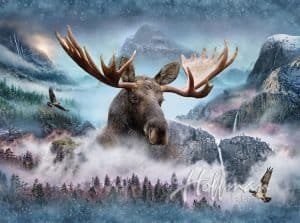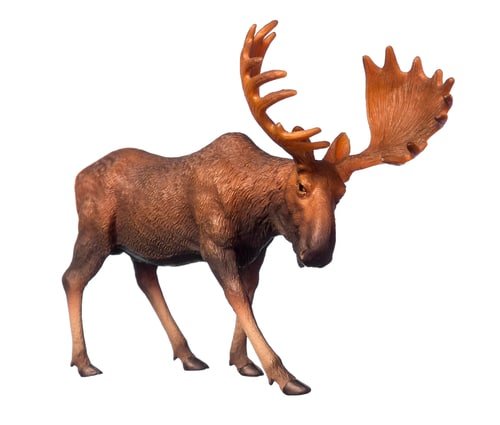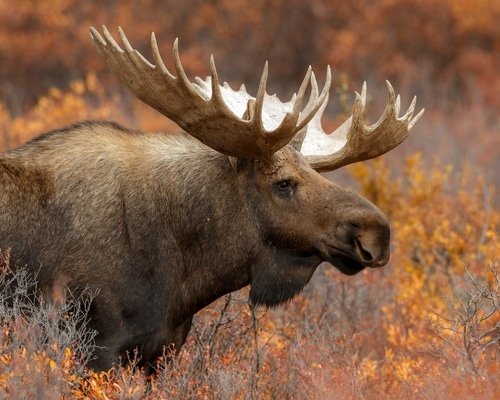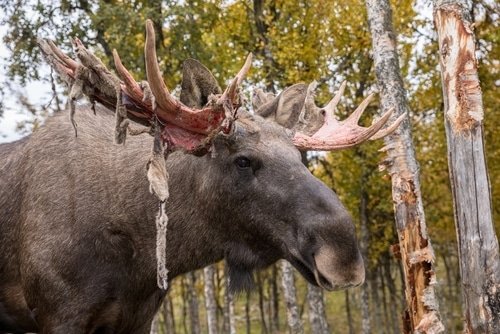Welcome to a fascinating exploration of moose national symbols! In this article, we’ll delve into the world of these majestic creatures and their symbolic significance in representing countries. National symbols are powerful cultural icons that encapsulate a nation’s core values and identity.
They are often chosen for their historical or natural significance and can range from animals and plants to flags and landmarks. In this context, the moose has emerged as a symbolic ambassador for various countries worldwide.
Definition of a National Symbol
A national symbol can be defined as a widely recognized representation that embodies a country’s people’s collective identity, heritage, or aspirations. It serves as a visual shorthand for everything that a nation stands for – its history, culture, values, and even its geographic features. These symbols become ingrained in the public consciousness over time and hold immense emotional value.
Importance of National Symbols in Representing a Country’s Identity
National symbols shape how people perceive and connect with their country. They serve as powerful tools for fostering unity and instilling pride among citizens. When individuals see these symbols – whether on flags, currency, or other cultural artifacts – they evoke strong emotional responses deeply rooted in shared experiences.
By embodying an entire nation within their imagery or representation, national symbols help forge bonds between diverse communities while celebrating commonalities. In the case of moose national symbols specifically, they often highlight aspects such as natural beauty, resilience, strength, or even folklore associated with these magnificent creatures.
Moose as a National Symbol
Moose as a popular national symbol in various countries
The moose, with its imposing stature and distinctive antlers, has captured the imagination of people worldwide, making it a beloved and recognized national symbol in several countries. From Canada to Sweden and even Norway, the moose has become emblematic of these nations’ rich natural heritage.
Its grandeur and unique characteristics have made it an ideal representation of wild beauty and strength. In many instances, the moose holds a special place as a national animal and an important cultural icon.
Historical significance and cultural associations with the moose
The historical significance of the moose as a national symbol can be traced back to its deep connections with indigenous cultures across different regions. For example, in Canada, indigenous peoples regard the moose as a sacred animal that embodies balance, wisdom, and harmony with nature. This reverence for the majestic creature has further solidified its status as a key part of Canadian identity.
In addition to its historical importance, cultural associations with the moose have also contributed to its symbolic value. The moose represents resilience in harsh environments and adaptability.
Its ability to navigate through forests effortlessly inspires individuals facing challenges or seeking personal growth. Furthermore, some nations have incorporated elements related to their history or folklore into their perception of the moose.
These connections foster pride in their heritage while celebrating this magnificent animal. Overall, whether for its physical grandeur or symbolic implications within cultures across borders, it is no wonder that countries choose to embrace the regal presence of this noble creature in their national symbols.
Moose National Symbols Around the World
Canada: The Majestic Moose on Canadian Coins and as an Official Emblem
When it comes to embracing the moose as a national symbol, Canada takes the cake. You’ll find these magnificent creatures gracing Canadian coins, specifically the quarter. The image of a mighty moose standing tall against a northern landscape serves as a reminder of Canada’s vast wilderness and its appreciation for nature.
Not only limited to coins, but the emblematic use of moose is also seen throughout Canadian culture and history. From indigenous artwork to provincial flags, the moose holds an esteemed place within Canada’s national identity.
The Significance of Moose in Indigenous Cultures within Canada
The moose’s significance runs deep in Indigenous cultures across Canada. It symbolizes strength, agility, and adaptability – traits that are valued by many indigenous communities. The moose represents sustenance and survival; its meat is highly nutritious, while its skin provides warmth and protection against harsh climates.
Additionally, various First Nations have folklore associated with the moose, often depicting them as spiritual beings or guides in nature. These cultural beliefs further reinforce the importance of this majestic animal within indigenous communities.
Sweden: The Iconic “King of the Forest” as a Swedish National Symbol
In Sweden, Nature reigns supreme, and it’s no wonder that they’ve chosen their own “king” – the majestic moose – as their national symbol. Known affectionately as “the king of the forest,” it represents Sweden’s deep connection with nature and wildlife preservation. Sweden boasts an abundance of forests where these gentle giants roam freely.
Their presence captures Swedes’ hearts and is celebrated through various festivals like “Älgens Dag” (Moose Day). Moreover, you’ll find plenty of moose-themed souvenirs and merchandise that allows locals and visitors alike to showcase their love for these magnificent creatures.
Norway: The Mythical “Elk” as a Symbol of Norwegian Wilderness
Norway has its own unique take on the moose, referring to it as the “elk.” While some may argue that there is a distinction between elk and moose, in Norway, the two terms are used interchangeably. The “elk” holds a special place in Norwegian folklore and legends. Often depicted as a creature of mystery and wonder, it represents the untamed wilderness that pervades Norway’s landscapes.
As with other Nordic countries, legends surrounding elks often involve mythical creatures or spirits associated with forests and lakes. These stories reflect the reverence Norwegians hold for their natural surroundings and highlight their deep-rooted connection to the wild.
Overall, moose national symbols around the world showcase how these magnificent creatures capture not only a country’s natural beauty but also its cultural heritage. From Canada’s emblematic use of moose in coins and indigenous symbolism to Sweden’s celebration of nature through festivals and merchandise, and Norway’s mythical associations with elks in folklore – these national symbols pay homage to an animal that embodies strength, resilience, and harmonious coexistence with nature.
Lesser-Known Moose National Symbols
Alaska: The Alaskan Statehood Quarter featuring a Bull Moose
When it comes to lesser-known moose national symbols, we cannot overlook the captivating design featured on the Alaskan statehood quarter. The coin showcases a magnificent bull moose, standing tall and proud against a backdrop of scenic mountains and forests. This design was chosen to represent Alaska’s natural beauty and its deep-rooted connection to wildlife.
The majestic presence of the moose on this coin serves as a reminder of the vast wilderness that defines Alaska’s landscape. It is an emblematic use of the moose, perfectly capturing the essence of this remarkable state.
Finland: The Finnish “Mörkö” or “Haisuli” from Moomin Stories
Moving across continents, we discover another fascinating lesser-known moose national symbol in Finland – “Mörkö” or “Haisuli.” These endearing characters are part of Tove Jansson’s beloved Moomin stories, which have captured the hearts of children and adults alike worldwide. Mörkö, also known as Groke in English translations, is depicted as a fearsome creature with glowing eyes and icy breath.
However, beneath its intimidating exterior lies a sense of vulnerability and longing for acceptance. Mörkö has become an iconic character in Finnish culture, symbolizing overcoming fears and finding one’s place in the world.
In addition to Mörkö, another memorable character related to moose symbolism in Finnish literature is Haisuli. Haisuli is portrayed as a mischievous thief who often disguises himself as a moose while causing trouble for other characters.
Although Haisuli may not have the same fame as Mörkö, he adds an element of playful mischievousness often associated with these majestic creatures. The popularity of Moomin stories in Finland has given rise to a wide range of moose-themed merchandise.
From plush toys and mugs to clothing and home decor, the image of Mörkö or Haisuli adorns various products, allowing people to carry a piece of Finnish culture and these enchanting moose characters with them. While moose national symbols have been widely recognized in Canada, Sweden, and Norway, it is equally intriguing to explore these lesser-known representations of moose in Alaska’s statehood quarter design and the beloved characters Mörkö and Haisuli from Finnish Moomin stories.
These symbols not only celebrate the beauty of nature but also evoke emotions and narratives that resonate with their respective cultures. The diverse use of moose as a national symbol across different countries showcases the enduring appeal and significance of this majestic creature in shaping national identities.
Rarely Known Facts about Moose National Symbols
Canadian Quarter Controversy
One fascinating but rarely known fact about moose national symbols revolves around the Canadian quarter. The controversy arises from the depiction of a caribou on the Canadian quarter instead of a moose.
Many people mistakenly believe that the animal on the coin is a moose, but it is actually a caribou, which is another iconic Canadian animal. This mix-up has led to debates and discussions among numismatists and coin enthusiasts, adding an interesting layer of trivia to Canada’s national symbols.
Conclusion
The moose holds a prominent place among national symbols in various countries, including Canada, Sweden, and Norway. Its majestic presence in these nations’ culture, folklore, and natural landscapes makes it an emblematic representation of their identity and connection to nature. Despite occasional controversies or mix-ups like the Canadian quarter’s caribou confusion, the enduring popularity of moose national symbols remains undeniable.
These symbols remind us of the beauty and significance that wildlife can hold in shaping our collective heritage. So let us embrace these magnificent creatures as they continue to grace our national flags and evoke feelings of pride and appreciation for our diverse world.







